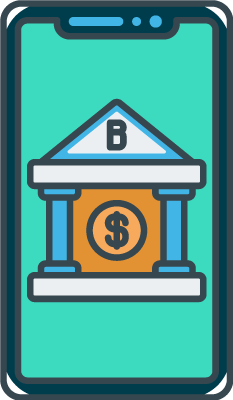Table of Contents
What is a Neobank?

A neobank is a technology company that provides financial services similar to traditional banks but often with lower fees and cheaper rates. Customers will interact with their neobank typically through an app on their phones. Neobank apps are often accompanied by an official website that customers can also utilize for banking purposes.
Traditionally, banking was done in a brick-and-mortar location with physical paperwork and interactions with real people. Neobanks are combating traditional banking sentiments by moving their customer experience to a digital option. Neobanks are exploding onto the scene in the financial technology (fintech) industry with new demand for neobanking technology such as apps, software, and other technologies hoping to enhance customer experience and create an efficient and effective online banking service.
Most banks offer their customers a personalized online banking experience that coincides with their physical locations. Neobanks offer the same, or better, online banking experience without physical bank locations which allows them to offer better prices in terms of interest rates, general fees, or transfer fees.
 Why are Neobanks Gaining Popularity?
Why are Neobanks Gaining Popularity?
Neobanks are gaining popularity following the wake of the financial crisis lasting between 2007 and 2009. They earned this name by directly competing with large corporations in the financial services industry. Neobanks have been digital disruptors and are transforming the banking sector in a similar fashion to Uber and Lyft evolving the transportation industry.
Neobank’s popularity has grown since the 2008 financial crisis and has amassed huge numbers of customers. For example, one of the largest neobanks in the United States, Chime, is estimated to have 12 million customers in February 2021. Compared to February 2020, Chime gained over 4 million users in just a year. Going into the year 2023 experts predict that neobanks will continue to gain new customers as a result of their ease of use and the shift to a digital economy.
What is the Difference Between a Neobank and a Traditional Bank?
Neobanks offer similar services to traditional online banks, but differ in certain characteristics. The main difference and part of the reason neobanks are able to charge such competitive prices is the fact that neobanks lack traditional physical locations. Many traditional banks will have online resources and in some cases even an entire division of the bank dedicated to online banking; however, they are also accompanied by physical locations.
Furthermore, traditional banks offer all of the services expected of a bank including loan products, investments, checking and savings accounts, and CDs. Neobanks will often specialize their services in a particular area of banking. For example, some neobanks focus all of their services and efforts on spending and savings.
One of the major differences between traditional banks and neobanks is the difference in governmental regulation. Neobanks in the United States are still subject to acquiring a banking license. However, in other countries such as India, neobanks are not required to apply for and receive a banking license and in turn are not recognized by India’s Reserve Bank of India.
Currently in the United States, neobanks are not directly regulated but instead their partner banks are regulated. For example, if a neobank is partnering with the Bank of America, the Bank of America would be subject to regulation under all federal banking laws. Bank of America is then required to ensure all of the practices and actions of the neobank are enacted according to that same law. The partner bank is subject to examination by the FDIC, the Federal Reserve itself, or the Office of the Comptroller of the Currency (OCC).
Neobanks are typically tasked with providing frequent information on their dealings and overview to their partner banks to continuously ensure the neobank’s actions adhere to regulations. With the rise in popularity of neobanks, regulation is likely to see an uptick in the coming years. Much like the boom of cryptocurrencies, government bodies will need time to review information and issues with the new industry in order to put in place policies that will protect both the organizations and the users.
What are the Benefits of Using a Neobank?
 Neobanks have gained popularity for a variety of reasons but none are more prevalent than ease of use. Decades ago, to even check your bank balance you would need to go to the bank and ask a teller. In modern times, most banks have online resources, but neobanks have become the first online only option for financial services. Applying for and opening a new account with neobanks are much more efficient and stress free since it will typically be done entirely online. Some neobanks also do not check the financial history of people applying for an account, leading many individuals with bad financial history to open and utilize an online bank account.
Neobanks have gained popularity for a variety of reasons but none are more prevalent than ease of use. Decades ago, to even check your bank balance you would need to go to the bank and ask a teller. In modern times, most banks have online resources, but neobanks have become the first online only option for financial services. Applying for and opening a new account with neobanks are much more efficient and stress free since it will typically be done entirely online. Some neobanks also do not check the financial history of people applying for an account, leading many individuals with bad financial history to open and utilize an online bank account.
You will be able to access your banking information and funds at any time of the day, anywhere in the world with the use of neobanks. Furthermore, neobanks are able to reduce or eliminate certain costs associated with operating physical locations and employing the locations. This allows for neobanks to have more competitive fees and rates for customers to utilize when sending or receiving funds. The competitiveness of neobanks will challenge traditional financial institutions, requiring innovation and expanding of existing online services.
Many individuals find their situation better suited for the use of neobanks compared to brick-and-mortar financial institutions. However, neobanks aren’t for everyone. If you have a job that pays in cash deposits or regularly sends wire transfers, many neobanks will not support these services. Moreover, if your account is used mostly for payments or savings, the competitive pricing neobanks are able to offer makes the switch to a neobank account beneficial.
Are Neobanks Safe?
Through their partnership with traditional banks, most neobanks are FDIC-insured. This means that user deposits up to $250,000 are protected through the neobanks own funds or through a larger bank.
Some neobanks are making the push to be recognized as their own banking entity by acquiring a national banking charter. In 2020, Varo, a popular neobank, became a nationally chartered bank with its own FDIC insurance. This creates another risk to traditional financial institutions that were working in conjunction with neobanks.
Summary
Neobanks are quickly gaining popularity in consumers’ eyes for their ease of use, competitive pricing, and safety of use. As the industry and fintech as a whole begin to expand rapidly into the digital economy, it is important to understand how shifting consumer demand impacts your financial service business.